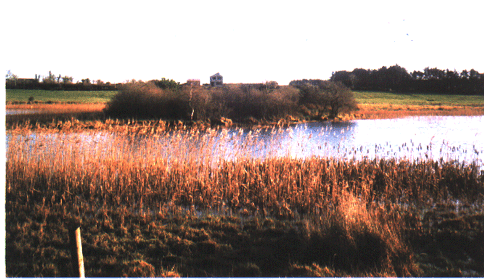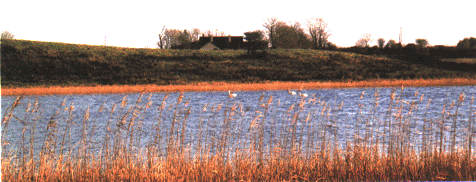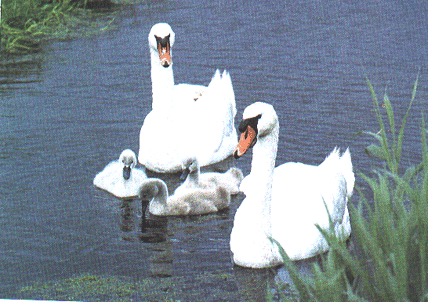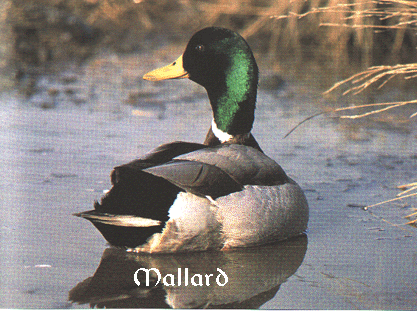

Terms of Reference:
This is a Report on Drumady Lough. I have included information on plants, animals, birds and fish that live on the Lough, and facts about the Lough together with 'old sayings'. I studied and researched these topics for this project and I also took some photographs of the Lough.
Source of Information:
I got information from Clar I.R.D. and from the Farm Development Service in Claremorris.
I researched information in the local County Library in Claremorris.
I also got information by word of mouth from the neighbours of the Lough.
Facts About The Lough
The Lough is situated about 5 miles from Claremorris in the Parish of Crossboyne. It lies between the townlands of Drumady and Cunlaghfadda. It covers 49.907 acres, 28.559 in Drumady and 21.348 in Cunlaghfadda. The surface of water is 190.7. There is a river from the lake leading to the river Robe. The adjoining lands are owned by 8 different farmers, Gallaghers, Glynns, Prendergasts and McNamaras on the Drumady side of the Lough and McHughs, Keanes, McNamaras, Trenchs and Joyces on the Cunlaghfadda side.

There are remains of a crannog (Illaun - a fort) situated on the Lough. It covers .205 acres. Crannogs were lake dwellings. The name comes from the Irish word crann which means tree. The crannog was built by driving a circle of timber-posts into the bed of the Lough and then layers of turf, wood and stones were piled up inside until it rose above the level of the water. In this way a man-made island was created.
The Fairy Tree

As well as a crannog there is a Fairy Tree near the Lough. Generations back, people believed that you couldn't cut down these trees because they thought that the fairies would bring them bad luck. In 1947, the year of the 'Big Snow' a man living nearby went out one evening to herd his stock but went astray. After some time he saw a light and decided to walk toward it without realizing he was actually crossing the Lough. He and the neighbours believed that the fairies led him safely across the Lough. Also on another occasion, on a beautiful, fine day, a farmer had just saved his hay in the field where the fairy tree was, when a gust of wind blew all the hay out into the Lough. People definitely believed that the fairies did this.
Stories about the Wildlife

Drumady Lough is well known for its wildlife especially the otter. In Spring time when the otter has its young, the female otters roam around the neighbouring farmyards in search of food and sometimes they frighten people when they appear to eat their animals and birds meal. On one occasion, last year, they went to a house and tried to get in through the door which was very frightening for the occupants. Most of the time they are seen swimming in the lough.
In the last few years there are at least 4 or 5 swans in the Lough, where previously there were only 2, who fought away any intruders all year round, as they tried to keep the lake for themselves and their young. It may have taken them a few days to fight away unwanted guests but they always succeeded. However one day, when they were migrating, one of them hit the electricity cables near the lake and got injured. It died a few days later. That was the end of the swan family who kept out intruders for many years. The older people of the area believed that when these swans built their nest to hatch their eggs on the brink of the Lough that there would be a bad summer, but if they built their nest on land jutting out into the Lough there would be a fine summer.
The male swans protect their young until they are about 6 months old and then they send them away to survive on their own.
There are also wild ducks to be seen on the Lough during the summer. They like to hatch their eggs on the crannog and when they are about 2 or 3 days old you can see them being taught to swim by their parents. There are about 3 different types of fish that inhabit the lake: Perch, Pike and Eel.
Perch is the most common fish caught by people. Sometimes you would be 3 or 4 days fishing and you may not catch anything and on another day you might catch a large number of the shoal. The Eel is mostly caught by using nets which have ben left set for a few days. Pike is very rare and it is hard to catch.
An Accident on the Lough
In the late 1800's, a man drowned in the Lough while fowling. He was the son of Lord Brown, a wealthy landlord who owned a large estate outside Westport. John Sweeney, a man from the area, went out on the Lough with his boat in search of the body and recovered it. The Brown family were so grateful they they offered him some land on their estate outside Westport but he didn't like to move from the area.
 Mute Swan
Mute Swan
This big bird weighing up to 12 kg is white with a black knob, lower bill and legs. Its upper bill is orange. the black basal knob on the upper bill stretches to its forehead and is the best distinctive feature of the Mute Swan. The Mute Swan holds its neck curved while swimming, bill bending downwards. It can be often seen to hold its wings up above the back like a shield. The Mute Swan is a silent bird, unable to sing, but it will his or snort when annoyed or provoked.
The Mute Swan breeds in the coastal regions of the North, Baltic, Caspian and Black Sea. The distribution has considerably widened during the past twenty years. It is partly due to people who have semi-domesticated the Mute Swan keeping it for decorative reasons in town parks. Such a living place has often become a breeding place. As regards Estonia the Mute Swan is widespread in the Western Archipelago and the western coastal regions of Estonia.
The first swans appear when there are the first patches of open water and the last ones leave when the bodies of water have completely frozen. The Estonian proverb 'when swans leave, it will snow,' holds the truth. A relatively large number of swans will winter in an area if there are favourable weather conditions such as feeding, but there are many problems due to freezing water and other factors.
The Mute Swan prefers coastal bays and lakes with rich vegetation to bare islets in the sea. It begins to breed at the end of April or the beginning of May. There are usually four to eight big, greenish-grey eggs in the clutch. They hatch in approximately thirty-five days later. The newly-hatched young do not resemble the beautiful elegant adults at all. They are brown and 'ugly ducklings'. They are able to fly at the beginning of September.
Adult swans do not have any enemies in nature. The bill of the Mute Swan is a dangerous weapon that can be used for striking deep wounds. It uses its wings as well and hits of the edges of these are comparable with fists' blow by a man. They will defend their eggs fiercely and often duel intruding swans to death. An angry swan is dangerous even to people: if aggravated it will willingly attack.
The Mute Swan was introduced to Ireland by the Normans. They were gifts to Lords and owning a swan was seen as distinguished and noble. Irish people have always admired swans yet assumed they were lonely and the great Irish mythological tale ' The Children of Lir' illustrate these beliefs.
The Mute Swans is most endangered by water pollution. It is under law protection.
Duck
Duck, name collectively applied to numerous species of a family of waterfowl. Ducks differ from geese and swans of the same family by their shorter necks and legs, and other anatomical features. They inhabit all continents except Antarctica, and most of the world's islands. The legs of most ducks are placed far apart and towards the rear, making them clumsy walkers but efficient swimmers. The underplumage (down) which is buoyant and insulating, is kept water-resistant by frequent preening with oil from the uropygial, or preen, gland at the base of the tail feathers. Ducks, with the exception of mertganisers, have spatulate bills lined with bony notches, or lamellae, for straining plant and animal matter from water. Some island species have lost the power of flight, but most ducks of northern continents are highly migratory. In a few species, the sexes are alike in colour, but in most the males are brighter and more boldly pattterned.
Eel ( Anguilla anguilla)
Vital statistics
Length: Up to 142 cm.
An unmistakable species characterised by a very long thin body, dorsal and anal fins which are continuous around the tail, a lack of pelvis fins, rudimentary scales, and an life history which has only been clarified in the last sixty years. The Eel is very common in fresh waters where it spends a large part of its life as an immature 'yellow eel' , feeding nocturnally on invertebrates and small fish. From September to December, those Eels which have become silvery with the onset of sexual maturity descend to the sea undeterred by short overland stages through wet grass. Male Eels remain for seven to fourteen years in fresh waters and reach 24-51 cm in length; female stay for nine to nineteen years before starting their extraordinary migration and grow to a length of 33-100 cm. An Eel lived for 55 years in captivity.
Perch (Perca fluviatilis)
Vital Statistics
Maximum weight:7lbs (3.2kg)
Average weight: 6-8 oz (170-228g)
Maximum length: 20in (50 cm)
Life span: 13 years
The perch is a handsome fish, with striking looks well suited to its predatory life. It flanks are olive-green with six or seven black stripes, camouflaging it among weeds and reeds. The tail is rather small so it is not a high speed swimmer, but it can cruise fairly fast for long periods.
Follow The Feeding
Perch are hunters, praying on their species. Fry feed on water fleas and other tiny crustacea but they soon graduate to insect larvae such as blood worms. If small enough fish are available, perch switch to a mainly fish diet when they weigh about 4oz (113g). Perch that have made this transition grow very rapidly. When there is no more prey of this type, perch remain stunted, still weighing only 4oz (113g) at about seven years old. Young perch hunt in schools lying in wait, among water plants until small fish such as bleak or roach stray too close. The school then sets in pursuit, harrying the quarry until it is too tired to swim further. Perch catch their pray by biting the tail repeatedly from behind and below to restrict swimming. Characteristically the catching and swallowing of the perches prey is always tail first. Perch usually eat small fish with a 1-2lb (0.45-0.9kgs) specimen typically taking prey of about 1-2oz (28-57g). Odd though it might seem, perch seem particularly fond of catching and eating the fry of smaller members of their own species.
Life in School
Perch prefer slow moving or still waters with a good head of small prey species. Good visibility is essential for their style of hunting and so they do best in clear water. They can also survive in relatively fast flowing rivers if there is not to much suspended silt making the water cloudy. Perch are not found in high, rocky streams or in acid lakes. When young perch form schools consisting of one age group but as they grow older become more solitaire. This is not because of older fish lose the instinct to form schools but is due to the shrinking of each school of perch as fish die and are eaten.
The Pike
Maximum weight:70lb(32kg)
Maximum length:4 ft 2in (1.27m)
Average weight caught:7-8lb (3.3-3.6kg)
Life span: 18-25 years
Fast, efficient and streamlined, the pike cannot be mistaken for any other fish. Most of its characteristics are adaptations to its predatory lifestyle. Camouflage colouring, eyesight, body form and fin arrangement all contribute to the pikes success as a hunter.
Hunting Habits.
With their camouflage and short-lived bursts of speed, pike prefer to ambush their prey rather than chase it. They lurk, hidden in weeds, waiting for the quick sprint followed by feeding.
The jaw is extremely flexible, allowing large meals to be swallowed whole; small (jack) pike will often demonstrate this by gobbling up their siblings. Prey is usually taken from the side and then manoeuvred round to be swallowed head first.
When the water conditions prevent the pike's superb eyesight from being effective, it can fall back on its efficient sense of smell. It also has a highly sophisticated tracking system rather like radar.
Otter
Aquatic carnivore found worldwide except in Australia, New Zealand, and Antarctica. In the common species distributed throughout Europe and Asia, the body may attain a length of 75 cm (30 in), with a tail half as long as the body. The head is broad and flat, with short, rounded ears, the blunt snout bears lateral, slit like nostrils. The ears and nostrils can be closed when the animal is diving. The fur is chestnut, the legs are short but strong, and the webbed feet have claws. A similar species is found in North America.
Otters live in dens, usually by the side of the water and with an underwater entrance to the den. They feed on fish and also on small mammals, birds, frogs and crayfish. The animals breed in the spring, and authorities have reported a gestation period of about 61 days for the species already mentioned. Certain investigators have also observed delayed implantation in the North American species, with a gestation of almost 12 months. Development still lasts only two months, however, since almost no development occurs between mating and the time when the fertilised eggs are implanted in the uterus. The litters range from one to five pups, which stay with the mother for about a year.
Water Lily
Water Lily - common name for a small family of aquatic flowering plants, and for its representative genus. The family includes about 70 species. Its leaves are usually peltate - that is, the leafstalk (petiole) is attached at the centre of the leaf rather than at an edge. The leaves often float on the water's surface, maintaining their position, even if the water rises, by continuing stalk growth. Water lilies typically grow in quiet waters covering deep, saturated, oxygen-poor soils. Oxygen needed for root growth is supplied by air passages extending down the leaf petioles. Many water lilies are grown as pond ormanentals, and numerous hybrids have been produced.
Members of the representative genus, with floating leaves, are also called lotuses. Two species were both represented in ancient Egyptian art. The family also contains the gigantic water lilies of the Amazon.
Watercress
Watercress, common name for an aquatic perennial herb of the mustard family. The herb, which is native to Europe, is cultivated in springs and wet ground in temperate climates for use as food in salads and garnishes. The yellow or white flowers have four sepals, four petals, six stamens, and a solitary pistil. The fruit is a long slender silique, or elongated capsule. Watercress is grown from either seeds or cuttings. After flower buds bloom, the leaves become extremely pungent and can no longer be used as food.